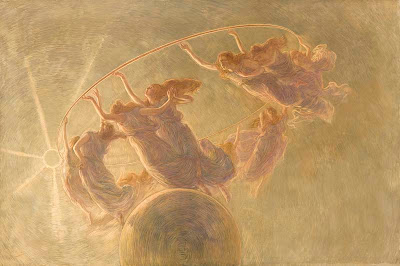
La Fondazione Cariplo, Milano
Date: c. 1899
Technique: Oil and tempera on canvas, 134 x 200 cm
This work aroused little enthusiasm among critics when it was shown in Venice at the 3rd Esposizione Internazionale d’Arte della Città di Venezia in 1899 as regards both its subject, the symbolic meaning of which escaped them, and the application of paint in separate colours. The art dealer Alberto Grubicy, who was responsible together with his brother Vittore for the spread of Divisionism in Italy, maintained his faith in the painting’s merit and continued to show it in exhibitions, including one in Munich in 1901 and a solo show in Venice in the same year. Having entered the collection of Carlo Sacchi in 1919 to hang in Milan alongside other masterpieces by the artist as well as Divisionist paintings by Vittore Grubicy, Emilio Longoni and Giuseppe Pellizza, it was auctioned together with the other works in separate lots in 1927. Cariplo bought it for the sum of 170,000 lire, having agreed with the collector that a sizeable proportion of the amount would be donated to two clinics for the treatment of tuberculosis, namely the Villa dei Pini in Urago d’Oglio and the Opera Leone XIII in Chiavari.
Previati reinterpreted the subject, an iconographic theme in existence since the decorative painting of the Renaissance era, drawing inspiration also in the title from the then celebrated ballet of the same name in the third act of La Gioconda, composed by Amilcare Ponchielli to a libretto by Arrigo Boito. First performed in Milan in 1876, the opera was based in turn on a play by Victor Hugo.
The painting shows twelve female figures representing the hours and mythologically personifying the seasons. Set in cosmic space flooded with light between the Sun and the Earth, they dance in a circle that alludes to the constant and never-ending succession of day and night. The dance thus becomes an allegory of time as the law that governs life. As presented in Divisionist painting, it also suggests the idea of a universe perceived as pure light and pure music, a recurrent concept in Symbolism and especially in the poetry of Baudelaire and Mallarmé. This was no new subject for Divisionist painters, having already been depicted in 1888 by Giovanni Segantini in The Morning Hours (Milan, private collection). Previati was also to return to it in later years in works such as the triptych The Day (Milan, Camera di Commercio, dell’Industria e dell’Artigianato).
Source 1
Source 2
Source 3

No comments:
Post a Comment